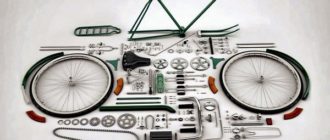The emergence of two-wheeled transport on city roads in large numbers with the arrival of heat makes you involuntarily think about the question, “What if you ride a bicycle to work?” Savings one. Reducing weight – two. Maintaining the vitality of the body – three. Plus: mobility, independence from traffic, strengthening the muscles in the legs, as well as sufficient load on the musculoskeletal corset. All in all, so far, just one plus.
If you have a practical bike for the city, you can safely move from stuffy buses on two-wheeled transport. It’s just a matter of choosing a route, learning how to ride properly on the roadway and enjoy an active lifestyle. About this we will talk a little later, but for now, let’s outline the main advantages of the bicycle as a transport to get to work or school.
The advantages of commuting to work by bicycle
Experts have long ago figured out and checked everything. All we have to do is study the information they’ve gathered bit by bit. So, the benefits of regular cycling:
- Noticeable improvement in brain activity. During outdoor exercise, the blood is oxygenated, resulting in the activation of neurons and the creation of new cells in the hippocampus (the area responsible for memory and concentration). This just means that avid cyclists have a more flexible mind and good memory.
- Improved mood. Walking in the fresh air saturates the body with vitamin D, which promotes the production of serotonin and dopamine (the hormones responsible for a good mood).
- Reduced stress levels. Moderate exercise after a stressful day at work is the best way to discharge negative emotions and cope with nervous fatigue. While a person is cycling his bicycle, his nervous system relaxes and his brain gently goes into a meditative state.
- Improved vision. While riding the bike, the cyclist constantly switches his attention from one object to another. Such exercise effectively strengthens the muscles of the eyeball and improves vision.
- Strengthening the immune system. In the process of cycling, the lungs work in an enhanced mode, which allows you to train the respiratory system, as well as increase the flow of nutrients to the blood cells. In addition, riding a bike strengthens the heart muscle, which means cyclists are less prone to heart attacks, strokes and other pathological conditions.
- Employee mobility. A motorist is much more likely to be late for work than a bicyclist. The latter cannot physically be stuck in automobile traffic for several hours. Only in the case of a serious accident can a two-wheeler driver be late for work.
- Lack of problems with parking space. Finding a place for a compact bike is much easier than for a car. To secure your iron friend from intruders, you just need to buy a good bike lock.
- Efficiency. Imagine how much money is spent just on fuel alone for a car. A bicycle in this regard costs absolutely free. You should also take into account repair costs – a car is more expensive by all parameters.
- Protecting your privacy. Motorists like to drive each other at traffic lights. In public transport can give a leg or insult each other. None of this can happen to a cyclist who is riding peacefully in the bike lane.
As you can see, the bicycle for the city dweller – it is not only a personal trainer, but also a comfortable means of transportation that allows you to arrive at work on time.
Disadvantages
Along with the obvious advantages, there are some disadvantages, which can significantly adjust plans and make you continue to commute to work by public transport. We will consider the most obvious of them, and also tell you how you can solve the problem:
- Lack of showers. Riding a bike in one way or another leads to increased sweating. If you are an employee of a prestigious company, a specific smell and stains can make a repulsive impression. The way out: take your time riding and keep a change of clothes at work. The problem is easily solved also by a special outfit for cyclists, which is well permeable to air, but at the same time does not allow gusts of wind to penetrate under clothing.
- Lack of parking space. Not every building has a well-maintained parking lot. The problem is solved simply – the bike can be parked at a nearby building or near the nearest tree. In this case, you need a good bike lock and an alarm system.
- Unfavorable weather. Very often it is this factor that makes you get off the bike and ride in a stuffy bus. The problem is solved by buying sunscreen and outfit with dry-effect. To protect yourself from muddy splashes, it is enough to put fenders on your bike. You can also buy a special umbrella that attaches over your head. The optimal option – a special raincoat for the cyclist, which will reliably shelter from moisture.
- Fear of the road. Even the presence of a specially designated path for cyclists does not guarantee absolute safety. Therefore, to cope with his fear, you can pave the route through the city parks and yards.
As you can see, all problems are solvable. Moreover, even winter is not a reason to use public transport. You can ride a bicycle in winter if you approach the process intelligently.
Choosing a route
You should think in advance about the route you will take to get from home to work by bicycle. Today you can do this with the standard Google Maps app. We recommend choosing the easiest and shortest route to work, and back could be a detour, to relieve your head after a busy day, as well as to give the body enough exercise.
It is also advisable on a day off to ride a bicycle on a particular route to understand how much time it takes to get there, with or without traffic jams. And now consider the most common routes in the city.
Bicycle lanes
In large cities, there are special lanes reserved for bicyclists and other two-wheeled vehicle drivers. As a rule, there are not and cannot be cars on them. Pedestrians have the right to walk in bicycle lanes, even though bicycle lanes are designated for pedestrians. They are not obliged to give way to a cyclist, but the driver of a two-wheeled vehicle has priority in a cycle lane.
Roads
If your city does not have designated bicycle lanes, you can ride your bicycle to work on the roadway. Anyone who is 14 years old or older may ride on a public road. They must ride in the general traffic flow and not obstruct other traffic.
Parks
A great option if you ride to work through a city park. There is no turmoil, exhaust fumes and noise. There is only one nuance – while driving on the paths of a city park, pedestrians have a preference. And here there is a high probability of meeting with dogs, which will not miss the opportunity to throw themselves at the feet of the cyclist.
Sidewalks
Another area where a cyclist can ride in case there is no way to get to the side of the roadway. We draw your attention to the fact that cyclists have one important advantage – in just a few seconds, dismounting from your iron horse, you can turn into a pedestrian.
Choice of equipment
Go out without an elementary protection is impractical. Of course, to buy a complete outfit does not make sense if you are not engaged in professional cycling. But some security measures should be taken all the same:
- In sunny weather, it would be wise to wear sunglasses.
- At any time of year, you should wear bright clothes, so as to increase their visibility on the road.
- At night or in cloudy weather you should “complete” reflective elements.
- Never be superfluous knee pads, elbow greaves and special gloves that will protect the joints in the event of an accidental fall.
Going out of town, you should take with you a repair kit, which comes in handy in case of a punctured wheel. Many people are skeptical about the importance of a bicycle helmet. However, this safety feature should not be neglected.
How to Start Cycling to Work
If you are mentally ready to switch from public transport or a car to a bicycle, but still doubt your strength, we recommend going through the following points:
- Check the technical condition of your bicycle. Pay particular attention to the wheels, brakes, and transmission.
- Lay out a route and try to ride your bike along it to time it and memorize the route.
- Think about your closet. The best option is to have a “change” at work.
- Don’t forget the elements of protection.
- Think about where you will leave your bike and how to secure it. Take into account that finding a stolen bike is not very easy.
- Learn basic repairs. On the road can happen anything, so carry a set of bicycle tools – it does not take much space.
- Learn the rules of the road and your rights and responsibilities as a cyclist. This will help avoid unpleasant situations on the road.
If all of the above points do not cause you concern, you can safely ride out. Cycling to work is a pleasure. And very soon you will be able to make sure of it.
Conclusion .
At first sight it may seem that riding a bike to work – it’s not convenient, not practical and tedious. But in practice, this method turns out to be much more effective than traditional ways. Riding a bicycle, you will not run into harmful granny, who will certainly decide to teach you about life. Cycling, you will not be sneezed on by a man with a cold. Riding your bike every day is good for your health, saving money and caring for nature.









